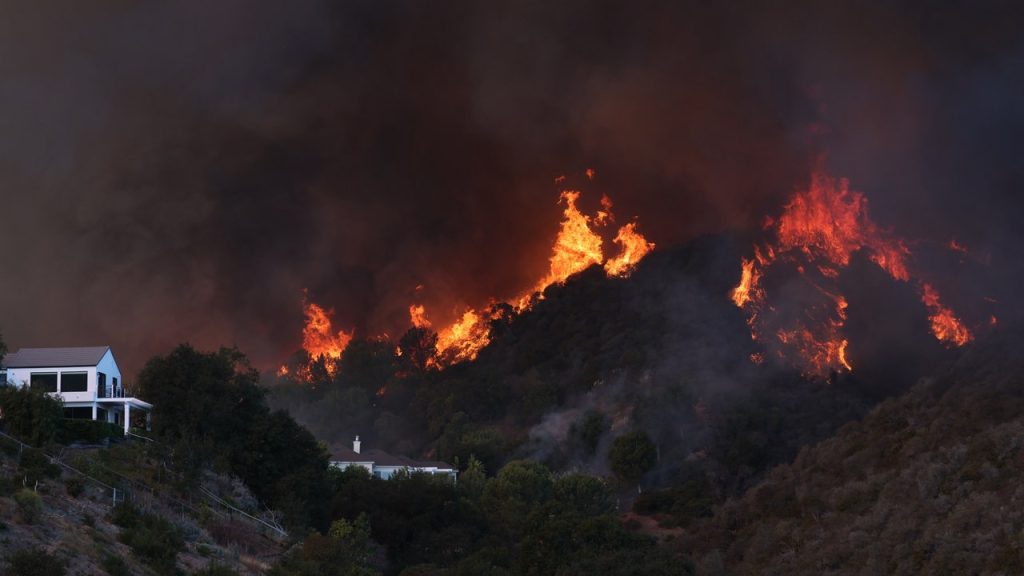The Southern California region is facing a dual threat of rapidly spreading wildfires, forcing widespread evacuations and challenging firefighting efforts. One fire, currently unnamed, is raging through the Pacific Palisades, while the Eaton Fire is consuming acres of land near Pasadena. Combined, these infernos have displaced more than 30,000 residents from their homes, creating a chaotic and uncertain situation. The intensity and rapid spread of the fires are attributed to a combination of factors, including extremely dry vegetation, fueled by prolonged drought conditions, and powerful Santa Ana winds. These winds, with gusts exceeding 80 mph in some areas, are not only fanning the flames but also grounding aerial firefighting efforts, severely limiting the ability to combat the blazes from the air.
The Santa Ana winds, known for their dry, down-sloping nature, are creating a perilous environment for firefighters. These winds are forecast to be among the strongest in over a decade, further exacerbating the already challenging conditions. The high-velocity gusts are picking up embers and carrying them long distances, creating spot fires ahead of the main fire front, making containment extremely difficult. The dry vegetation acts as perfect fuel for the wind-driven flames, enabling the rapid spread of the fires across the landscape. This “ember cast” phenomenon creates a dangerous and unpredictable situation, requiring firefighters to constantly adjust their strategies and potentially extend evacuation zones to protect lives and property.
Firefighters on the ground are facing what can only be described as a herculean task. Battling extreme conditions including high winds, dry brush, and unpredictable fire behavior, they are working tirelessly to contain the blazes. The intense heat, smoke-filled air, and constantly shifting fire lines create a physically and mentally demanding environment for these first responders. The Santa Ana winds further complicate their efforts by making it difficult to predict the fire’s path and increasing the risk of flare-ups. Limited visibility due to thick smoke plumes further restricts their ability to assess the fire’s progression and deploy resources effectively.
The inability to utilize aerial support, including water-dropping aircraft and helicopters, is a significant setback in the firefighting efforts. The strong winds make it too dangerous for these aircraft to operate, eliminating a crucial tool for suppressing the flames from above. Aerial firefighting is particularly effective in reaching areas inaccessible to ground crews and quickly dropping large volumes of water or fire retardant on advancing flames. The grounding of these aircraft puts more pressure on ground crews, forcing them to engage the fires directly in extremely hazardous conditions. The absence of aerial support also limits the ability to create firebreaks, which are crucial for slowing or stopping the fire’s advance.
The widespread evacuations highlight the immediate danger posed by these fires. Residents in affected areas have been forced to leave their homes with little notice, seeking safety from the rapidly approaching flames. Evacuation centers have been established to provide temporary shelter for displaced residents, creating a challenging logistical undertaking for emergency responders and local authorities. The emotional toll on evacuees is significant, facing uncertainty about the safety of their homes and possessions. The prolonged nature of these fires, fueled by the strong winds and dry conditions, means that many residents may be displaced for an extended period, adding to the stress and anxiety of the situation.
The severity of these fires underscores the growing threat of wildfires in California, exacerbated by climate change and prolonged drought. The increasing frequency and intensity of these events highlight the need for comprehensive wildfire prevention and mitigation strategies, including improved forest management, community preparedness programs, and enhanced firefighting resources. The ongoing efforts of firefighters battling these blazes serve as a stark reminder of the dangers faced by communities located in fire-prone areas, and the importance of proactive measures to protect lives, homes, and the environment. The situation remains dynamic and uncertain, with the fires continuing to pose a significant threat.

